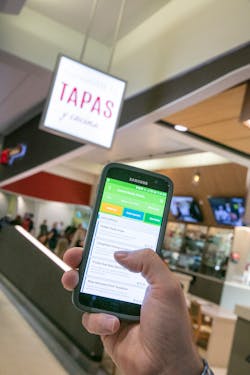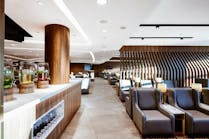Self-Service Takes Hold in the Future of Airport Concessions
Dallas Fort Worth International Airport (DFW) recently deployed three two-sided self-service kiosks within Terminal C. Passengers can utilize the units to order food and either pick it up at a concessions location or have it delivered to their gate
The kiosks are the first to be deployed at gates C6, C19 and C35. Participating vendors include Bánh Shop, Caribou Coffee / Einstein Bros. Bagels, Chili’s, Freshens, Maggiano’s Little Italy, Pizza Hut, Shake Shack and TGI Fridays.
Jeff Livney, chief experience officer for Grab, which deployed the kiosks, said the initial pilot was started to enhance the passenger experience within the terminal. Traveler feedback noted a lack of food options and the airport has limited space to address the issue.
“Terminal C is the oldest terminal at DFW,” he said. “It’s also the one terminal that hasn’t gone through a remodel and given the curvature of terminals at DFW and the fact that 80 percent of travelers are a once a year traveler and don’t really know their way around, there’s a lot of gate huggers that stay in the gate environment and if they don’t see a restaurant nearby that they want, then they don’t order anything.”
Food delivery options have increased at North American airports in recent years, so Grab partnered with Airport Sherpa to make it available. Livney said there’s an interest in delivery for a lot of airports, but there’s an issue with user adoption.
“We thought the kiosk is really the perfect bridge to that problem,” he said. “We can set up kiosks inside of the gate hold environment, especially in front of chokepoints where there’s not a lot of food options nearby and from an awareness standpoint, it’s already visible. They don’t need to know about or download a third part app that only works in this airport.”
According to metrics compiled in the pilot, there were 5,100 orders using the program in May. About 51 percent were placed on the Grab app; 28 percent were placed from the American Airlines App; 13 percent were placed at the kiosks; and 8 percent via the airport website.
The average check is $2 more via Grab compared to orders taking place at the counter.
Sea change in concessions
According to the 2019 OAG Airport Delight Report, 50 percent of travelers wait 45 minutes in lines at airports. Overall, 78 percent of passengers said they prefer human interaction compared to automation when it comes to concessions, but changing demographics show a need for investment by airports.
The report states millennials are 30 percent more likely to prefer automated concessions compared to travelers older than 50 years old.
“I think it’s more the nature of, there’s still not enough information and data in the hands of the average traveler to feel like there is something helping them to have a seamless travel experience,” said Vipul Nakum, chief product officers for OAG. “They’re relying on the idea of I’d much rather prefer a human interaction to deal with my delay issues, my rebooking issues, my getting through security process.
“The expectation is there must be more bodies that you can throw at this because every time I travel, I’m experiencing a wait period that’s unexpected or unacceptable.”
About 45 percent of all passengers stay near the gate due to concerns about missing their flight. About 26 percent said they would be more like to spend money if gate-side food delivery was available and 37 percent would spend more if pre-ordering on mobile devices for pickup were made available.
While only six percent of travelers have pre-ordered food or drink for pickup at a restaurant, 66 percent said they would consider doing it in the future. About 9 percent have ordered delivery to the gate and 62 percent are willing to try it.
Nakum said airports can look at technology to increase self-service ordering, but they should also look at adding more information about flights.
“If you look at why they’re waiting there, it’s because there’s not enough information being put in front of them with respect to delays and cancellations or even prediction information around delays and cancelations or the wait times, he said. “Can I be alerted 10 minutes before boarding and if that’s consistently happening, I’d be free to wander around retail and buy food and products and services.
Nakum said 78 percent of travelers in the report said they wanted more flight information, 77 percent wanted more information about security wait times and 75 percent wanted real-time updates on boarding times.
“If you think of the 70 percent and above, that’s a clear signal for airports that you definitely need to provide more information,” Nakum said.
Sarah Naqvi, executive vice president, chief information officer for HMSHost, said the company decided to offer more self-service options in airports given the changing nature of retail and airline, where it has grown and become an expectation for travelers.
“Our focus all along has been on the needs of the customers,” she said. “We really understand the needs and the desires and the options that the customers are looking for when dining with us and really responding to those needs.”
Naqvi said self-service also offers speed of service advantages, which reduces lines.
Livney said feedback has been positive so far, but they have been learning and adapting to enhance the system.
“DFW is funding the cost of the delivery for the pilot,” he said. “So there’s no cost to the guest between delivery or pickup.”
They initially thought delivery would be the bulk of the transactions because it was free, however, Livney said it has been really mixed. Travelers want to have control over their experience, so they want to go to the restaurant and pick it up themselves.
“It ranges from a quarter to three-quarters of transactions are delivery or pickup,” he said. “Some days 75 percent are delivery, 25 percent pickup; and other days it’s 75 pickup and 25 percent delivery.”
While it’s hard to say empirically that all of the transactions would not have taken place without the kiosks, Livney said they know some of the transactions are incremental.
“Overall a kiosk product generally drives a 10 to 30 percent higher average ticket, just because of visual merchandising, great product images, upselling, cross-selling and so forth,” he said.
Generations pushing the change
“We’ve become very social. We seem to expect certain things either when we’re doing online shopping, street side or within airports,” Naqvi said. “There’s an evolution, a change in culture driven by mobile evolution. There’s an expectation of technology, maturity of technology and maturity of understanding of technology by our customers.”
The frictonless experience and control over the purchase is embraced by the travelers, Naqvi said, and it gives them more options. HMSHost started looking at data at kiosks and found sales are much higher compared to those at the counter.
“People tend to feel more comfortable ordering what they want when they’re in control of that experience rather than speaking to an individual,” she said. “Our empirical data is in support of that experience and our understanding of customer behavior.”
The utilization of self-service technology varies across the different types of travelers. Frequent flyers are going to use apps embedded in airline systems, Livney said, while kiosks are drawing some business travelers and families.
“If they can walk to the kiosk and see the restaurants in the terminal and the menu of each and we can all browse and find what we want in a relaxing, lower stress environment,” he said.
There’s also a generational shift toward self-ordering systems. Besides comfort with technology, Livney said there’s also an aspect of control that younger travelers like.
They can also obtain easy access to information about dietary restrictions and what offerings are available from vendors.
“The two things we see with about 75 percent of travelers is the time savings and the convenience,” he said. “It’s the ability to be able to multitask.”
Naqvi said HMSHost is seeing a higher level of adoption and a different model of implementation of self-service in a fast-casual food compared to sit down casual dining. Fast-causal tends to have a full menu on self-service while sit down concepts may not offer a full menu because it can be too burdensome for customers.
“Our strategy has not been to implement technology just because we want to implement technology, but we want to strike a balance,” she said. “It’s about options and experiences that’s more important to us rather than which technology we should be deploying.”
Naqvi said deployment of self-service needs to be based on data. HMSHost will study customer behavior to understand expectations, travel paths and dwell times for travelers. The data leads to where certain technology should be placed.
“You certainly have to take into considerations out there like volume,” she said. “What the enplanements are, what types of airlines, the travelers’ language and what’s the language requirement.”
Self-service kiosks can also benefit smaller commercial airports as well. Livney said delivery service needs a high volume of customers from an economic standpoint and driving awareness can aid.
“We think the kiosk really helps in that sense and alleviates some of the issues of how do I get someone to download my proprietary app,” he said.
It can be difficult to justify delivery in smaller airports, however, kiosk ordering still can make sense without it, Livney.
Not just food anymore
Self-service is also growing as a popular option for travelers looking for a quiet space without accessing a lounge.
Jabbrrbox provides a private workspace modeled as the “modern day phone booth,” where travelers can access a private box allowing them a place to work and hold phone calls without the noise of the terminal.
The box has deployed in LaGuardia International Airport (LGA), John F. Kennedy International Airport (JFK), Cincinnati/Northern Kentucky International Airport (CVG), and Pittsburg International Airport (PIT). Company leaders said they expect to be in 25 terminals by the end of the year.
Brian Hackathorn, co-founder and co-CEO of Jabbrrbox, said there’s a need for some privacy in an increasingly mobile world while being to still connect with the outside world.
“In the aviation space, there’s all kinds of spaces available, but a large amount of spaces really don’t provide privacy,” Jeremy Jennings, co-founder and co-CEO said. “As aviation is starting to look more like hospitality and they’re thinking about the passenger experience, innovation, amenity and trying to provide that hospitality experience, we’re part of that solution.”
Jabbrrbox uses a 10-inch Elo touchscreen for the exterior and 24-inch inside. The touchscreens provide a consumer-friendly experience, similar to interacting with their personal devices. The screens are built to last in high-traffic environments where the devices are unattended.
Jennings said the boxes democratize the lounge experience because everyone can reach them and get in. Anyone with a credit card can enter the space.
The boxes have rolled out in smaller deployments with the units clustered together. As demand grows, they’re able to add more units.
“It’s going into the terminal conditioning the consumer to understand this is something available, so we will grow as demand grows,” Jennings said.
Having a private lounge also offers more opportunities for smaller or regional airports to enhance their passenger experience, especially if they have a larger amount of business travelers coming through their terminal.
“Often times, they have no lounges or independent lounges,” Hackathorn said. “If you look across the average of all airports, you’re looking at a 50 percent business travelers to 50 percent leisure traveler, so if you start looking at the smaller regional airports and realizing that half of the people flying through every day are business travelers and there’s not a lounge, they still need a place to go.”
Expect more changes to self-service
Mobile options can also make self-service options more appealing for smaller airports. Naqvi said if you can provide the same experience between a larger airport and smaller one by using the same technology between each area.
Naqvi said she expects mobile ordering to grow and sees kiosks as a temporary solution.
“People are going to go to their mobile devices. They want to use their own devices to engage with us, therefore, the form factors of the kiosks we’re deploying is with that future in mind,” she said. “It’s a more plug-and-play environment so we can quickly scale if that curve hits us faster than expected where customers transition to their own mobile devices
As self-service grows, it may change how airports think about their concessions programs altogether. Livney said it could be possible to have food offerings not visible to travelers on the concourse by having them developed in a centralized kitchen area and delivered to passengers.
“Say you’re in an airport and about to board a flight to inland China and you know that 70 percent of the people on the flight are from India and the only restaurant around that gate is a sushi restaurant that they may not want,” he said. “We can offer virtual concepts, have you order from a variety of restaurants that are not physically available in the terminal, but you can digitally see them, browse in your language and have the ability to transmit the order to an existing restaurant or commissary that may be below ground or less valuable real estate and then have the order brought to you at the gate or or pickup at another restaurant or automatic locker.
“There’s a lot of potential like that and we’ve got several airport partners looking at use cases like that and by looking at the flight information systems and airline data we can dynamically tailor what we offer.”
Grab is working with a partner on a concept at Denver International Airport that will change every six months. Livney said it will be powered digitally, so signage and ordering will go through the self-service panels, so they try new things.
“Poke bowls are huge right now, but will they last 10 years? Or be a fad? We don’t know,” he said. “Investing in that space for that long can be challenging from a concessionaire standpoint.”





